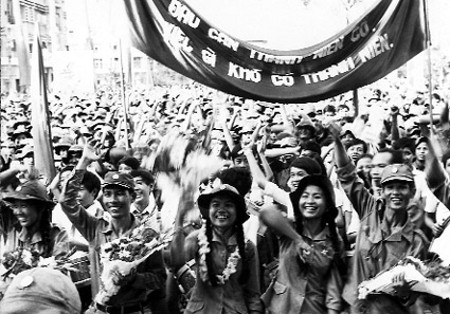
The information, documents, exhibitions, and displays on the struggle for the liberation of the South and the nation's unification reveal the important role played by Hanoi in actively supporting the Southern revolution with substantial human and material resources from the great northern rearguard.
| Thousands of the youth from the North responded to the "Three Ready" movement. Photo: Archive |
All for the front
In the archives of the exhibition "Hanoi - Aspiration for New Height" commemorating the 90th anniversary of the founding of the Hanoi Party Committee (March 17, 1930 - March 17, 2020), there is a note: "During the resistance against the US to save the country, Hanoi was the birthplace of revolutionary movements among various strata of the population, such as the 'Three Ready' movement of the youth; the 'Three Responsibilities' movement of women; the 'Truong Son Stick'; and the 'Pens Up, Off to Fight the Americans' movements.
Under the leadership and direction of the Hanoi Party Committee, on the night of August 7, 1964, at the meeting room of the headquarters of the Hanoi Youth Union at 43 Ly Thai To Street, Hoan Kiem District, the Executive Committee of the Hanoi Youth Union held an extraordinary meeting and unanimously launched the 'Three Ready' movement with the content: ready to fight, fight bravely; prepared to join the armed forces; prepared to go anywhere, do anything that the Motherland commands.
From the land of Thang Long, with a thousand years of civilization, the 'Three Ready' movement spread rapidly and became the revolutionary movement of the youth, according to the archives.
The 'Three Ready' movement in the North, along with the 'Five Volunteers' movement in the South, composed the heroic epic of Vietnamese youth fighting against the Americans, rallying all youth from all walks of life under the slogan "All for the Victory against the American Invaders". The youth, in their early twenties, without any personal calculations, had only one desire: to be organized and given missions by the Party and the military. The more intense the fighting, the more vividly the spirit and dynamism of the 'Three Ready' movement were demonstrated.
Thousands of Hanoi youth enlisted and fought on various battlefields in the South. Specifically, in the 10 years from 1965 to 1975, with 29 recruitment campaigns, Hanoi had over 89,000 youth head to the battlefield; organized training, and sent 42 reinforced infantry battalions to the Southern battlefield. Many factories and enterprises sent cadres, machinery, technical equipment, and supplies to the battlefield.
Faced with the urgent task of saving the country, supporting the revolution in the South, and defeating the imperialist American conspiracy, in line with the aspirations of millions of women, the Central Committee of the Vietnam Women's Union officially launched the 'Three Responsibilities' movement among women throughout the North. From a spark, the 'Three Responsibilities' women's movement became a widespread competitive movement in all the northern provinces.
After a short period, President Ho Chi Minh suggested that the Women's Union rename the 'Three Responsibilities' movement as the 'Three Responsibilities and Activeness' movement. This was a time when the Hanoi Party Committee directed the shift towards building the local economy under wartime conditions, continuing production alongside protecting production; promoting economic and cultural development; and preparing good combat plans, while actively supporting the South.
| Workers at the 8-3 Textile Factory in Hanoi in 1967. Photo: Archive |
Sharing the “fire” with the South
In the exhibition "Proud of 90 Years of Hanoi Party Committee," held at the Management Board of Hoa Lo Prison Historical Site in April 2020, many images recreated the resilient days amidst the bombing of the Capital.
Among them, the story of how the capital's military and civilian forces overcame numerous hardships and challenges and, together with the entire nation, contributed to the resounding victory of the "Hanoi - Dien Bien Phu in the Air" in 1972, stands out.
In 1972, due to the failures on the Southern battlefield, the imperialist Americans escalated, returning to wreak havoc in the North. On December 14, 1972, President Nixon approved the "Linebacker II" military campaign, massively bombing Hanoi and Haiphong, among others
Under the guidance of the Central Committee, the Central Military Commission, and the General Staff, the Air Defense - Air Force Command urgently completed the combat plan and deployed forces to fight the enemy.
Together with the whole country, under the leadership of the Party Committee, the military and people of the Capital vigorously promoted the national tradition of all people and all soldiers fighting the enemy. The Hanoi people led by the Air Defense - Air Force valiantly fought and won the resounding victory of "Hanoi - Dien Bien Phu in the Air". This forced the imperialist Americans to sign the Paris Agreement and withdraw their troops from Vietnam, marking a decisive turning point for the liberation struggle in the South and the national reunification.
Fourty-nine years have passed, but Hanoi continues to strive for constant development so that every time the hymn of liberation of the South and national reunification is sung, the lesson of harnessing the strength of the rearguard is recalled, the "heart of the nation" beats stronger, ready to stand with the whole country, for the whole country.








